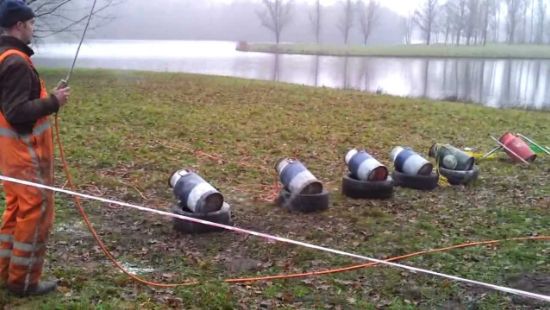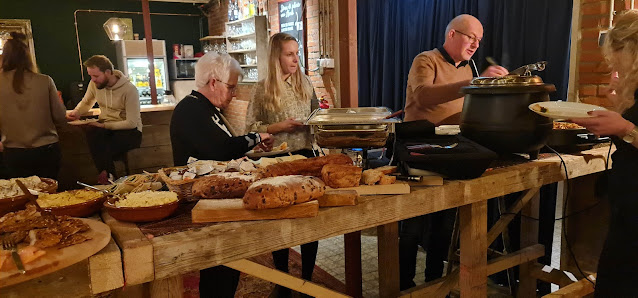Week 21 Drought
Week 21
A bit of a read, but we are in the middle of a drought . This article looks at the subsidence caused by the drying out of peat.
The Frisian peatland has declined sharply since the Second World War due to drainage for livestock farming, in the context of land consolidation. The subsidence is enhanced by the oxidation of dried peat: it combines with oxygen, causing it to dissolve, as it were, to burn. Because of 'rusting' peat, the soil on which agriculture is practiced comes closer to the groundwater level, which means that additional dewatering has to be done in order to keep the peat soil usable and passable. A major problem, because the drainage of the peat areas is causing hundreds of houses and old farms that are poorly founded to subsidence. Many buildings stand on wooden piles that are suddenly no longer under water as a result of drainage by Wetterskip Fryslân, the water board, the currently most frequently appointed scapegoat.
5,100 Buildings in Friesland are now damaged by pile rot and the loss of groundwater counter pressure. Poorly founded roads and cycle paths also subsidence due to subsidence and the settlement of peat.
In short: farmers want a low water level, citizens a high one. That battle is currently being fought in full force in Friesland, but also in other peat areas in the Netherlands. The Frisian peat soil, 60,000 hectares, decreases about 1 cm per year due to drainage for agriculture and oxidation. That is not small. The settlement of peat in wetlands, which arose after the end of the last ice age 10,000 years ago, can only be slowed down by raising the water level in nature reserves such as the Rottige Meente nature park, the Tsjonger and Lende valleys, but also in the adjacent agricultural areas themselves.
Reducing large CO2 emissions from peat with project Currency for peat
In all sectors, the Netherlands is looking at what can be done to limit CO2 emissions, including in the peat meadow program of the province of Fryslân. From this program there is the urgency to reduce CO2 emissions. Large amounts of carbon are stored in the peat. Every day that the peat comes into contact with the air, carbon in the form of CO2 is released into the atmosphere. In Fryslân, peat meadow areas are estimated to be responsible for 30 percent of total CO2 emissions. Apart from the greenhouse gases, there are many other negative consequences, such as the aforementioned subsidence, which causes roads and houses to subside, and nature areas dry out."Currency for Peat" is the method that makes it possible to demonstrably save CO2 in the Frisian peat meadow area. The controlling authority is the National Carbon Market Foundation. This guarantees CO2 savings. The CO2 certificates are sold on PlatformCO2neutral to companies, governments, farmers and citizens who want to avoid their CO2 emissions on a voluntary basis. This makes Valuta for Veen a new model with which the loss of income of farmers can be compensated.
Buyers include the Lemmer-based concrete industry IJB group (IJsselmeer Beton), the municipality of Fryske Marren (Joure) and agricultural trading and land management companies. More and more potential buyers, including many farmers, are applying to the Frisian Environmental Federation (FMF). The trade in CO2 certificates seems to be a success. Due to good sales, for example, the water level in the Hoaitepolder near Langweer can be raised by no less than half a meter.
An important principle at Valuta voor Veen is that the elevation of the ditch and groundwater level is voluntary and that the area retains its agricultural function. However, a higher water level, resulting in less or no peat oxidation, does have consequences for the various aspects of a dairy farmer's business in the peat meadow area, including with regard to the choice of grass, production and yield and the load-bearing capacity of the soil. . On wetter peat soils, less heavy machines can be used or vehicles already in use have to be modified. The plan for the CO2 certificates has been devised to compensate for the effort associated with a higher water level, and in particular the financial consequences thereof.
Rain Shortfall
ie how much less rain has fallen than the norm. (1976 the worst)
What can we do to keep our sanity in the midst of the catastrophes on so many levels? We can continue to love the people and the animals whom we love for as long as we can.
Boy's Toys
You cannot eliminate such a precipitation deficit with a few heavy showers. Because if a lot falls at the same time, you will discharge a relatively large amount via the rivers - something that is not included in the calculation of the precipitation deficit, as described above. Nature benefits from moderate rainfall for some time.
To eliminate the shortage to what is average for this time of year, you need the amount of rain that normally falls in May: 59 millimeters. And although it looks to be a bit more changeable this week, it will still remain too dry for the time being.






















Comments
Post a Comment